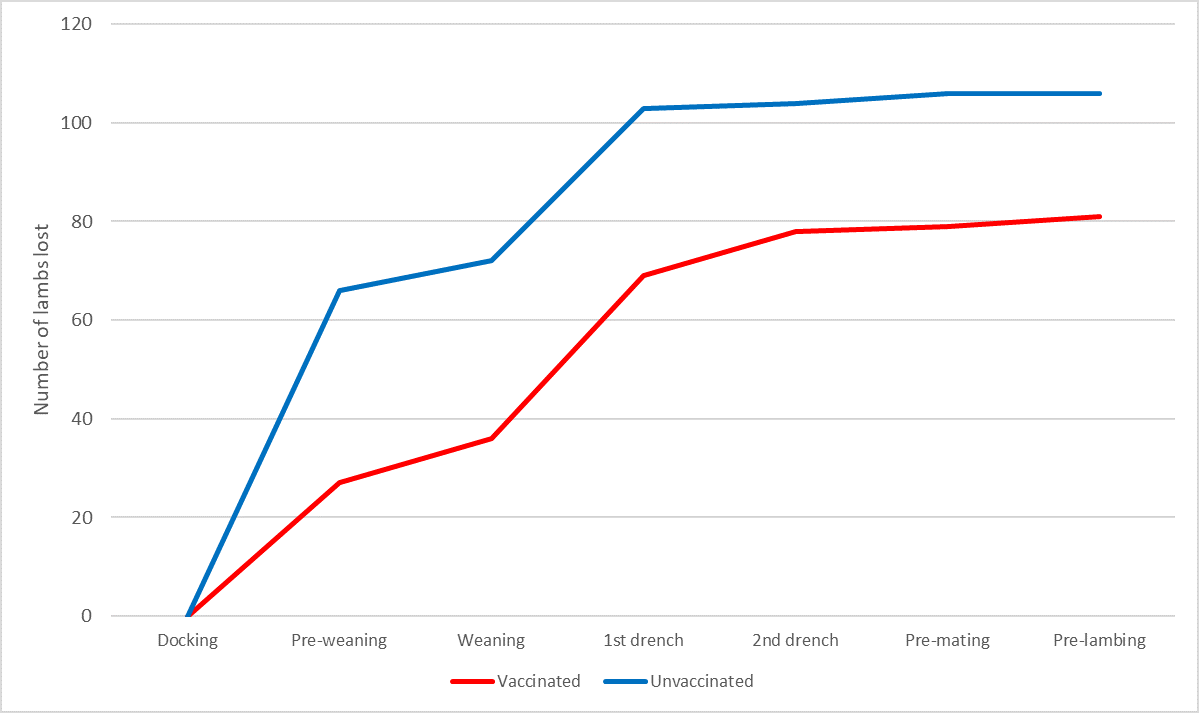Trial Objectives
- To provide information on the level and timing of lamb loss that occurs during the first year of life on hill country sheep and beef farms in New Zealand.
- To determine how much of that loss can be prevented through vaccination against the five main clostridial diseases, using a commercially available multivalent clostridial vaccine (Ultravac® 5 in 1 vaccine, Zoetis New Zealand limited).
- To determine the return on investment (ROI) from vaccinating lambs with Ultravac 5 in 1.
Method
The study was conducted on a single commercial hill country sheep and beef farm in the central North Island of New Zealand, which had never vaccinated their stock against clostridial disease. Lambs (3,414) were blocked on sex and randomly selected at docking into treatment (T1 = 1,705) and control (T0 = 1,709) groups. Treated lambs were vaccinated at docking and a booster vaccination given four weeks later, with 1mL of multivalent clostridial vaccine (Ultravac 5 in 1 vaccine). Control lambs were not vaccinated. Different coloured ear tags were used to identify the lambs in the treatment and control groups. All lambs were counted at docking (October 2019) and at six other management event times between docking and when the replacement hoggets were set stocked for lambing (August 2020). The number of lambs sold between each management event, from each group were also counted. The difference in the number of lambs from one management event to another, minus the lambs sold between these events was regarded as the lamb loss for that period. The difference in the numbers of vaccinated and unvaccinated lambs between management events, minus the lambs sold was regarded as the clostridial losses for that period.
Results
The total percentage of lamb losses from docking to pre-lamb was 6.2% and 4.8% in the unvaccinated and vaccinated lambs respectively (p=0.06). This is a 23% reduction in overall lamb deaths between the two groups.
Most lamb loss occurred after docking, followed by weaning (Figure 1). Less lamb loss occurred in the vaccinated lambs between docking and pre-weaning than in the unvaccinated lambs (T1 1.6%, T0 3.9%, p<0.0001). When the data was separated, based on sex the difference was mainly due to the lower female lamb losses in the vaccinated group in the period after docking (T1 0.6%, T0 4.4%, p<0.0001).
Figure 1: The cumulative lamb loss in vaccinated and unvaccinated lambs from docking to pre-lambing.

Conclusion
The practical implications of the findings from this study are that the vaccination of lambs with a multivalent clostridial vaccine (Ultravac 5 in 1) is highly effective at preventing clostridial losses particularly after docking. Based on the losses recorded in the current study and the average lamb sale price for the season, vaccination at docking and pre-weaning prevented 23% of the total lamb deaths in the vaccinated group compared to the unvaccinated group and returned a gross income 3.5 times greater than the cost of the vaccine.
It is the authors opinion that the deaths allotted to clostridial disease in this study are likely to be an underestimation of what is seen in unvaccinated flocks in most years. The reason for this opinion is that the drought conditions under which the trial was run were not conducive to clostridial disease. The drought experienced from January through to March prevented lush growth of pasture and hence reduced the risk of pulpy kidney. Not all lamb deaths due to Tetanus, particularly in male lambs after docking would have been prevented by one vaccination. Therefore, it is still recommended to complete a full vaccination program starting with the ewes pre-lambing to protect the ewes and the lambs over this high-risk period, until the lamb vaccination program can be started at docking.